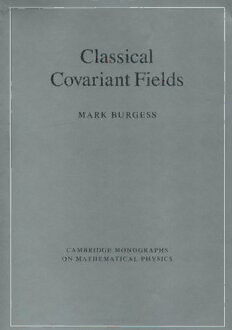Table Of ContentClassicalCovariantFields
Thisbookdiscussestheclassicalfoundationsoffieldtheory,usingthelanguage
ofvariationalmethodsandcovariance. Thereisnootherbookwhichgivessuch
a comprehensive overview of the subject, exploring the limits of what can be
achievedwithpurelyclassicalnotions. Theseclassicalnotionshaveadeepand
important connection with the second quantized field theory, which is shown
tofollowonfromtheSchwingerActionPrinciple. Thebooktakesapragmatic
viewoffieldtheory,focusingonissueswhichareusuallyomittedfromquantum
field theory texts. It uses a well documented set of conventions and catalogues
resultswhichareoftenhardtofindintheliterature. Careistakentoexplainhow
resultsariseandhowtointerpretresultsphysically,forgraduatestudentsstarting
outinthefield. Manyphysicalexamplesareprovided,makingthebookanideal
supplementary text for courses on elementary field theory, group theory and
dynamical systems. It will also be a valuable reference for researchers already
workingintheseandrelatedareas.
MARK BURGESS obtained his PhD in theoretical physics from the University
of Newcastle Upon Tyne in 1990. He held a Royal Society fellowship at the
University of Oslo from 1991 to 1992, and then had a two-year postdoctoral
fellowship from the Norwegian Research Council. Since 1994, he has been an
associate professor at Oslo University College. Dr Burgess has been invited
to lecture at universities and institutes throughout the world, and has published
numerousarticles,aswellasfivepreviousbooks.
This Page Intentionally Left Blank
CAMBRIDGEMONOGRAPHSON
MATHEMATICALPHYSICS
Generaleditors: P.V.Landshoff,D.R.Nelson,S.Weinberg
J.Ambjørn,B.DurhuusandT.Jonsson QuantumGeometry:AStatisticalFieldTheoryApproach
A.M.Anile RelativisticFluidsandMagneto-Fluids
J.A.deAzca´rragaandJ.M.Izquierdo LieGroups,LieAlgebras,CohomologyandSomeApplications
inPhysics†
V.BelinskiandE.Verdaguer GravitationalSolitons
J.Bernstein KineticTheoryintheEarlyUniverse
G.F.BertschandR.A.Broglia OscillationsinFiniteQuantumSystems
N.D.BirrellandP.C.W.Davies QuantumFieldsinCurvedSpace†
M.Burgess ClassicalCovariantFields
S.Carlip QuantumGravityin2+1Dimensions
J.C.Collins Renormalization†
M.Creutz Quarks,GluonsandLattices†
P.D.D’Eath SupersymmetricQuantumCosmology
F.deFeliceandC.J.S.Clarke RelativityonCurvedManifolds†
P.G.O.Freund IntroductiontoSupersymmetry†
J.Fuchs AffineLieAlgebrasandQuantumGroups†
J.FuchsandC.Schweigert Symmetries,LieAlgebrasandRepresentations: AGraduateCoursefor
Physicists
A.S.Galperin,E.A.Ivanov,V.I.OgievetskyandE.S.Sokatchev HarmonicSuperspace
R.GambiniandJ.Pullin Loops,Knots,GaugeTheoriesandQuantumGravity†
M.Go¨ckelerandT.Schu¨cker DifferentialGeometry,GaugeTheoriesandGravity†
C.Go´mez,M.RuizAltabaandG.Sierra QuantumGroupsinTwo-dimensionalPhysics
M.B.Green,J.H.SchwarzandE.Witten SuperstringTheory,volume1:Introduction†
M. B. Green, J. H. Schwarz and E. Witten Superstring Theory, volume 2: Loop Amplitudes,
AnomaliesandPhenomenology†
S.W.HawkingandG.F.R.Ellis TheLarge-ScaleStructureofSpace-Time†
F.IachelloandA.Aruna TheInteractingBosonModel
F.IachelloandP.vanIsacker TheInteractingBoson–FermionModel
C. Itzykson and J.-M. Drouffe Statistical Field Theory, volume 1: From Brownian Motion to
RenormalizationandLatticeGaugeTheory†
C. Itzykson and J.-M. Drouffe Statistical Field Theory, volume 2: Strong Coupling, Monte Carlo
Methods,ConformalFieldTheory,andRandomSystems†
J.I.Kapusta Finite-TemperatureFieldTheory†
V.E.Korepin, A.G.IzerginandN.M.Boguliubov TheQuantumInverseScatteringMethodand
CorrelationFunctions†
M.LeBellac ThermalFieldTheory†
N.H.March LiquidMetals:ConceptsandTheory
I.M.MontvayandG.Mu¨nster QuantumFieldsonaLattice†
A.OzoriodeAlmeida HamiltonianSystems:ChaosandQuantization†
R.PenroseandW.Rindler SpinorsandSpace-time,volume1:Two-SpinorCalculusandRelativistic
Fields†
R. Penrose and W. Rindler Spinors and Space-time, volume 2: Spinor and Twistor Methods in
Space-TimeGeometry†
S.Pokorski GaugeFieldTheories,2ndedition
J.Polchinski StringTheory,volume1:AnIntroductiontotheBosonicString
J.Polchinski StringTheory,volume2:SuperstringTheoryandBeyond
V.N.Popov FunctionalIntegralsandCollectiveExcitations†
R.G.Roberts TheStructureoftheProton†
J.M.Stewart AdvancedGeneralRelativity†
A.VilenkinandE.P.S.Shellard CosmicStringsandOtherTopologicalDefects†
R.S.WardandR.O.WellsJr TwistorGeometryandFieldTheories†
†Issuedasapaperback
This Page Intentionally Left Blank
Classical Covariant Fields
MARK BURGESS
OsloUniversityCollege
Norway
PUBLISHED BY CAMBRIDGE UNIVERSITY PRESS (VIRTUAL PUBLISHING)
FOR AND ON BEHALF OF THE PRESS SYNDICATE OF THE UNIVERSITY OF
CAMBRIDGE
The Pitt Building, Trumpington Street, Cambridge CB2 IRP
40 West 20th Street, New York, NY 10011-4211, USA
477 Williamstown Road, Port Melbourne, VIC 3207, Australia
http://www.cambridge.org
© Mark Burgess 2002
This edition © Mark Burgess 2003
First published in printed format 2002
A catalogue record for the original printed book is available
from the British Library and from the Library of Congress
Original ISBN 0 521 81363 8 hardback
ISBN 0 511 01942 4 virtual (netLibrary Edition)
Contents
Foreword xix
Part1: Fields 1
1 Introduction 3
1.1 Fundamentalandeffectivefieldtheories 4
1.2 Thecontinuumhypothesis 5
1.3 Forces 6
1.4 Structuralelementsofadynamicalsystem 6
2 Theelectromagneticfield 9
2.1 Maxwell’sequations 9
2.1.1 Potentials 10
2.1.2 Gaugeinvariance 11
2.1.3 4-vectorsand(n+1)-vectors 12
2.1.4 Thefieldstrength 14
2.1.5 Covariantfieldequationsusing Fµν 15
2.1.6 Twoinvariants 16
2.1.7 Gaugeinvarianceandphysicalmomentum 17
2.1.8 WavesolutionstoMaxwell’sequations 18
2.2 Conservationlaws 20
2.2.1 Currentconservation 20
2.2.2 Poynting’svectorandenergyconservation 21
2.3 Electromagnetisminmatter 22
2.3.1 Dielectrics 23
2.3.2 Covarianceandrelativemotion: theDopplereffect 25
2.3.3 Refractiveindexinmatter 26
2.4 Aharonov–Bohmeffect 28
vii
viii Contents
3 Fieldparameters 32
3.1 Choiceofparametrization 33
3.2 Configurationspace 34
3.2.1 Flatandcurvedspace 34
3.2.2 Vectorequations 35
3.2.3 Coordinatebases 36
3.2.4 Example: Euclideanspace 38
3.2.5 Example: Minkowskispacetime 40
3.3 Momentumspaceandwaves 42
3.4 Tensortransformations 43
3.5 Properties 45
3.6 EuclideanandRiemannianspacetime 47
4 Theactionprinciple 50
4.1 TheactioninNewtonianparticlemechanics 50
4.1.1 Variationalprinciple 52
4.1.2 δS: equationofmotion 54
4.1.3 TheEuler–Lagrangeequations 54
4.1.4 δS: continuity 55
4.1.5 Relativisticpointparticles 57
4.2 Frictionalforcesanddissipation 59
4.3 Functionaldifferentiation 60
4.4 Theactionincovariantfieldtheory 61
4.4.1 Fieldequationsandcontinuity 63
4.4.2 Uniquenessoftheaction 64
4.4.3 Limitationsoftheactionprinciple 66
4.4.4 Higherderivatives 68
4.5 Dynamicalandnon-dynamicalvariations 68
4.5.1 Scalarfields 68
4.5.2 Gaugeandvectorfields 69
4.5.3 Themetricandsecond-ranktensors 70
4.6 Thevalueoftheaction 71
5 Classicalfielddynamics 72
5.1 Solvingthefieldequations 73
5.1.1 Freefields 73
5.1.2 BoundaryconditionsandcausalityI 74
5.1.3 Positiveandnegativeenergysolutions 75
5.1.4 Sources 77
5.1.5 Interactionsandmeasurements 79
5.2 Greenfunctionsandlinearresponse 79
5.2.1 Theinverseproblem 79
5.2.2 BoundaryconditionsandcausalityII 82
Contents ix
5.2.3 GreenfunctionsinFouriermomentumspace 83
5.2.4 LimitationsoftheGreenfunctionmethod 84
5.2.5 Greenfunctionsandeigenfunctionmethods 85
5.3 ScalarfieldGreenfunction 87
5.3.1 TheWightmanfunctions 88
5.3.2 Boundaryconditionsandpolesinthek plane 90
0
5.3.3 RetardedGreenfunction 91
5.3.4 AdvancedGreenfunction 96
5.3.5 FeynmanGreenfunction 96
5.3.6 Commentoncomplexcontours 98
5.4 ScalarGreenfunctionsinrealspace 99
5.4.1 TheretardedGreenfunctionforn = 3asm → 0 100
5.4.2 TheG(±) andG forn = 3asm → 0 101
F
5.4.3 Frequency-dependentformofG andG inn = 3 102
F r
5.4.4 EuclideanGreenfunctionin2+0dimensions 102
5.4.5 Massivecase 103
5.5 Schro¨dingerGreenfunction 104
5.6 DiracGreenfunctions 106
5.7 PhotonGreenfunctions 106
5.8 PrincipalvaluesandKramers–Kronigrelations 108
5.9 Representationofboundstatesinfieldtheory 111
6 Statisticalinterpretationofthefield 113
6.1 Fluctuationsandvirtualprocesses 113
6.1.1 Fluctuationgenerators: G (x,x(cid:6))andG (x,x(cid:6)) 113
F E
6.1.2 Correlationfunctionsandgeneratingfunctionals 114
6.1.3 Symmetryandcausalboundaryconditions 118
6.1.4 Workanddissipationatsteadystate 119
6.1.5 Fluctuations 121
6.1.6 Divergentfluctuations: transport 126
6.1.7 Fluctuationdissipationtheorem 128
6.2 Spontaneoussymmetrybreaking 130
7 Examplesandapplications 131
7.1 Freeparticles 131
7.1.1 Velocitydistributions 134
7.2 Fieldsofboundparticles 134
7.3 Interactionbetweenmatterandradiation 137
7.3.1 Maxwell’sequations 137
7.3.2 Electromagneticwaves 138
7.3.3 DispersionandtheFaradayeffect 139
7.3.4 Radiationfrommovingchargesinn = 3: retardation 142
7.4 Resonancephenomenaanddampeningfields 146

